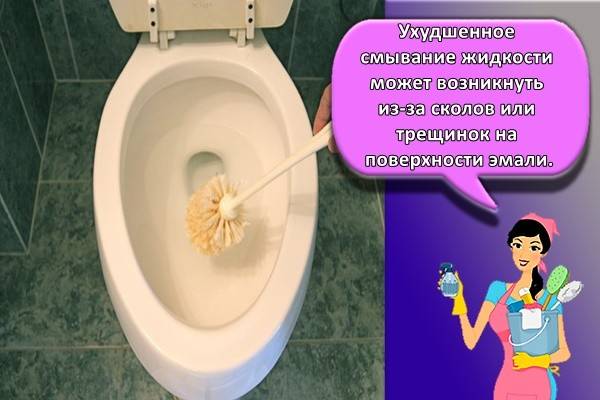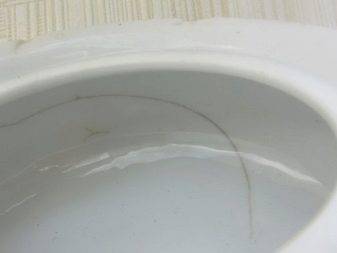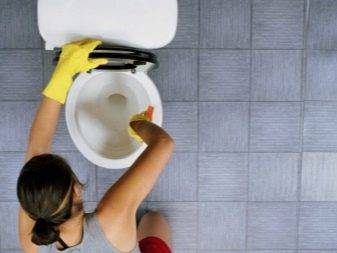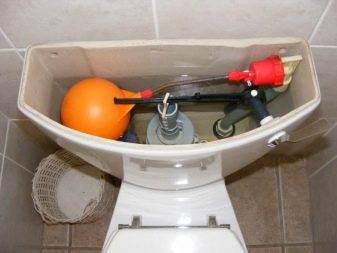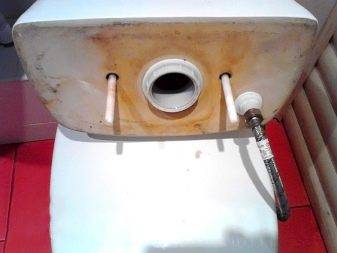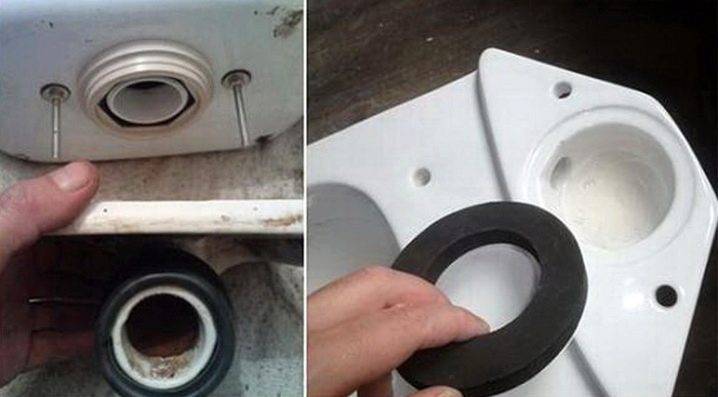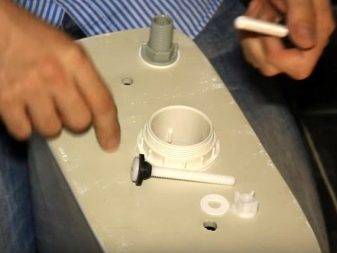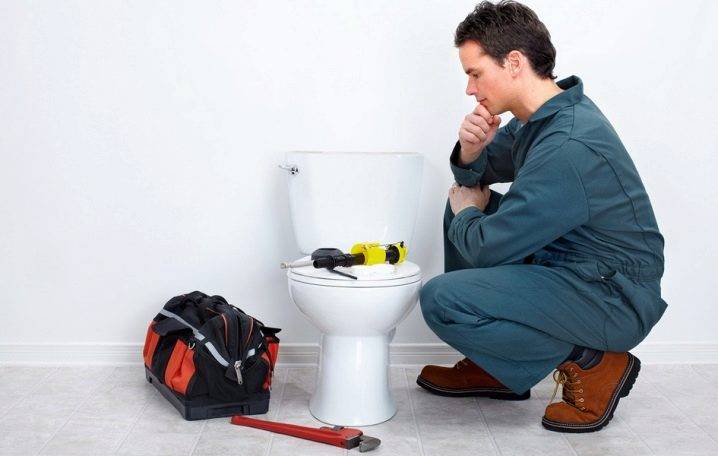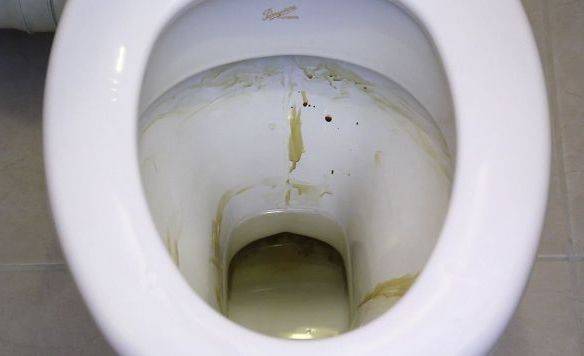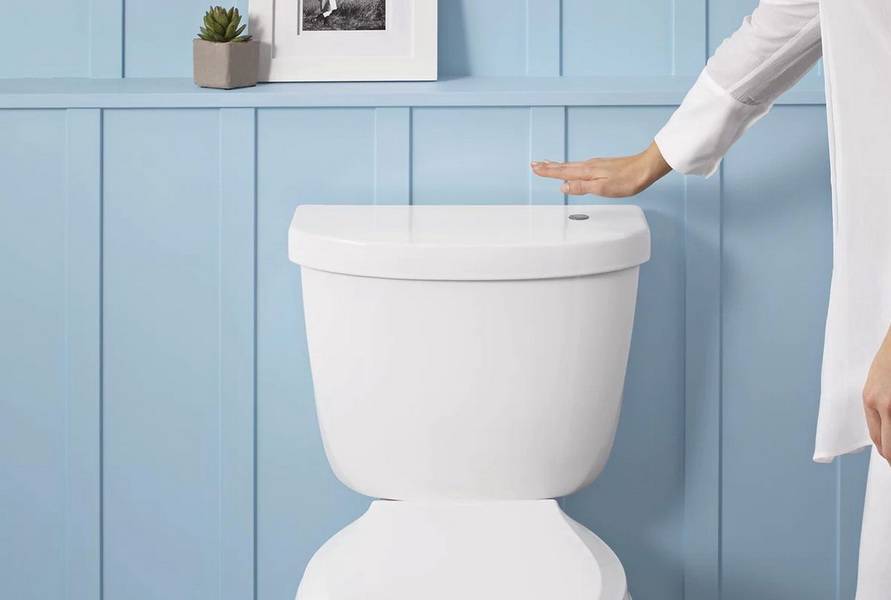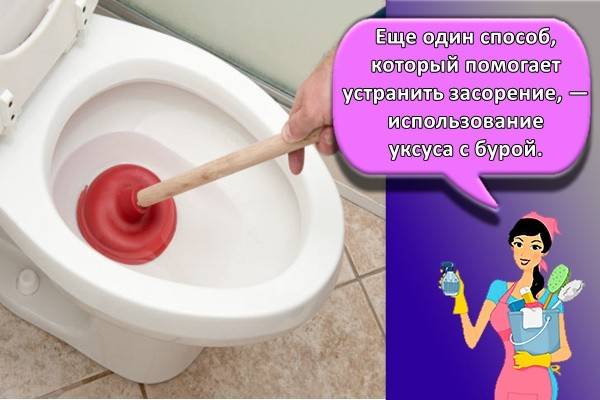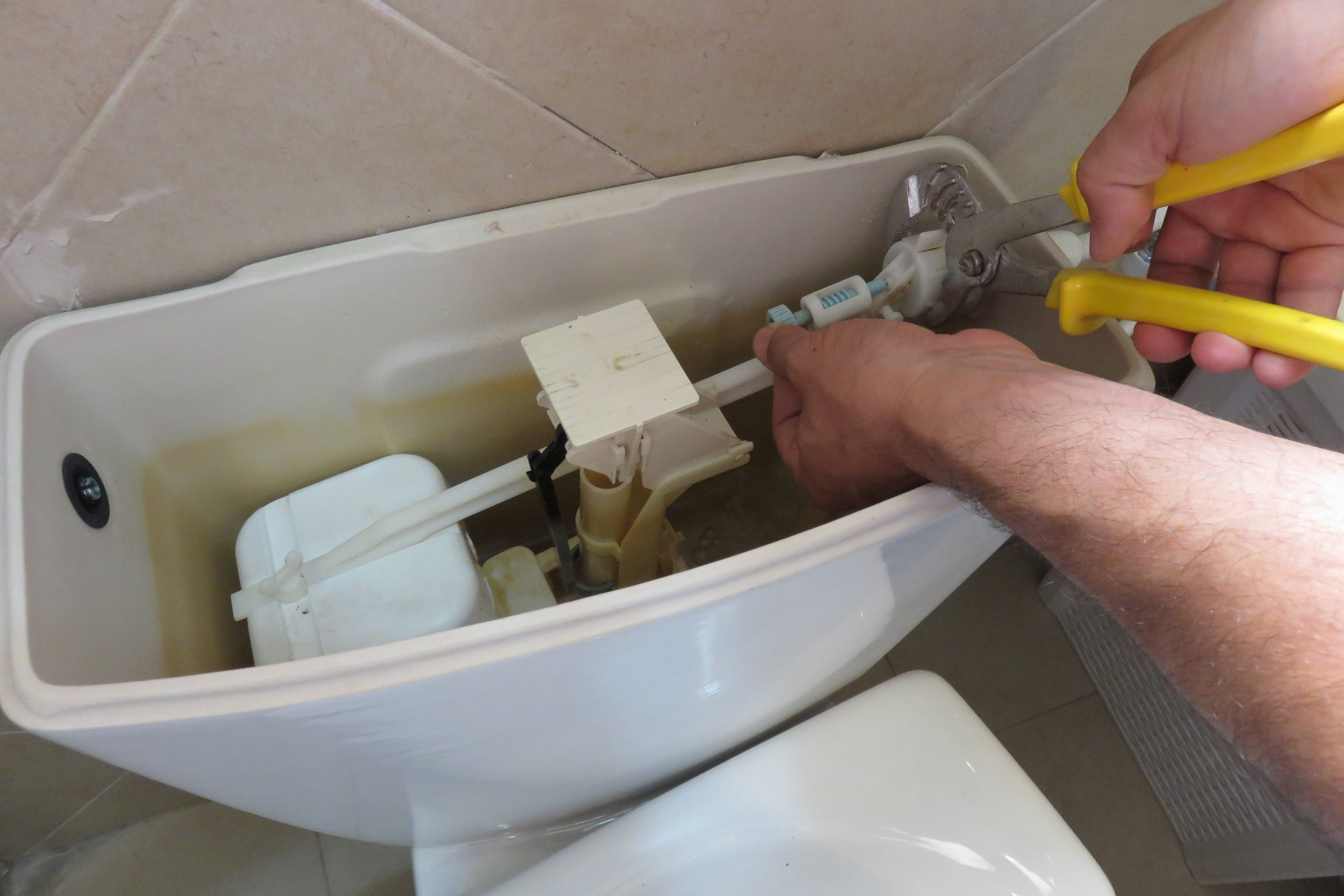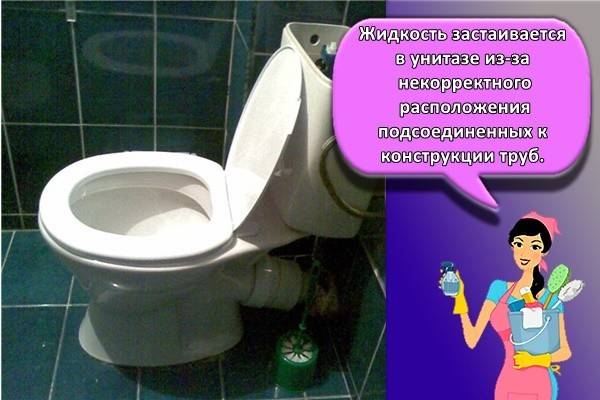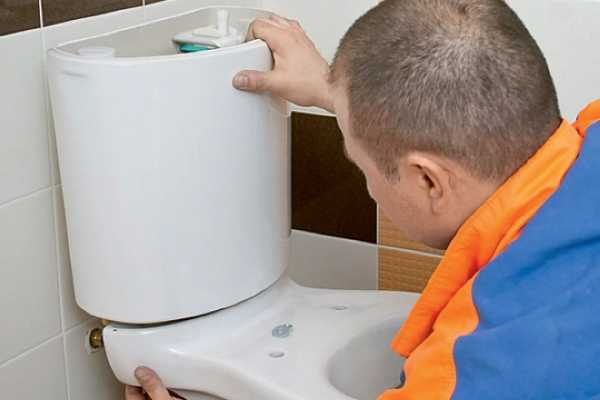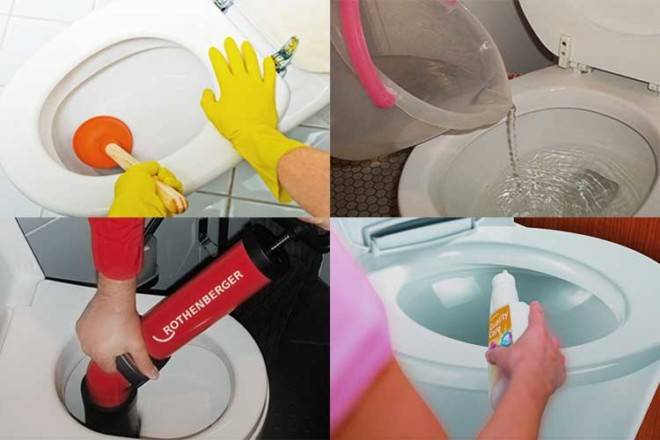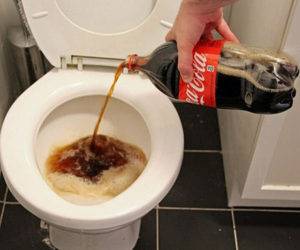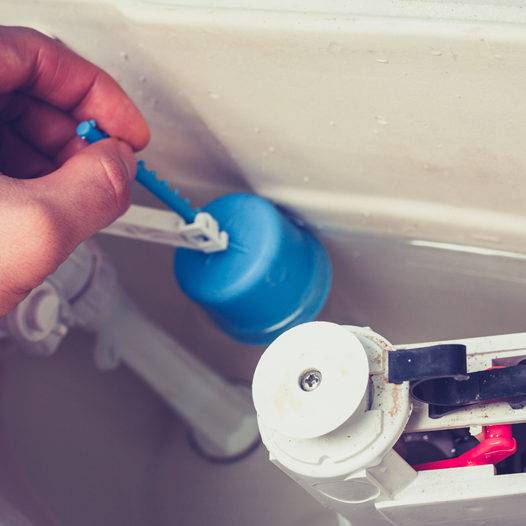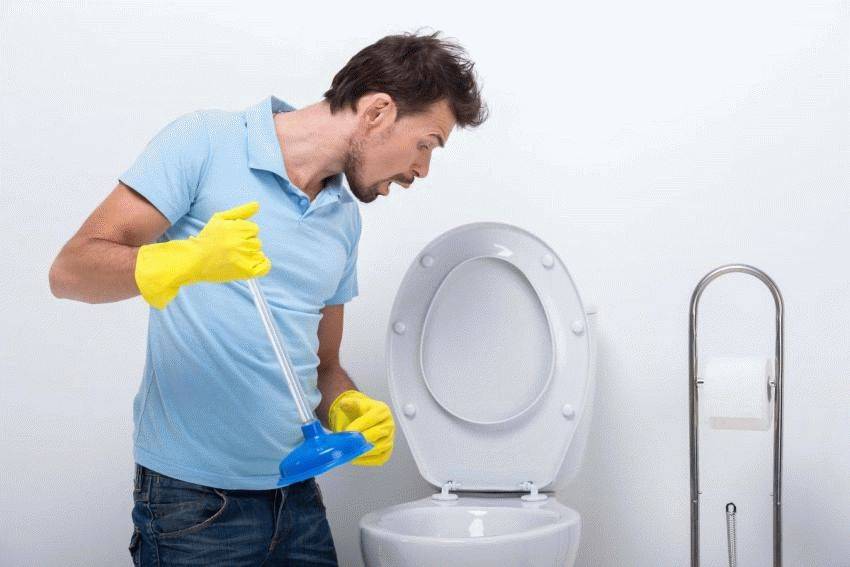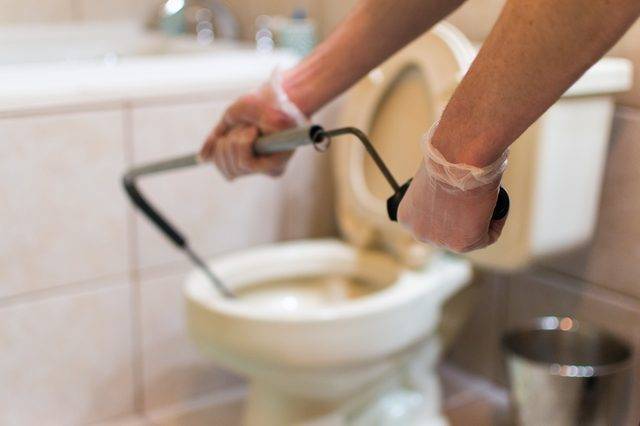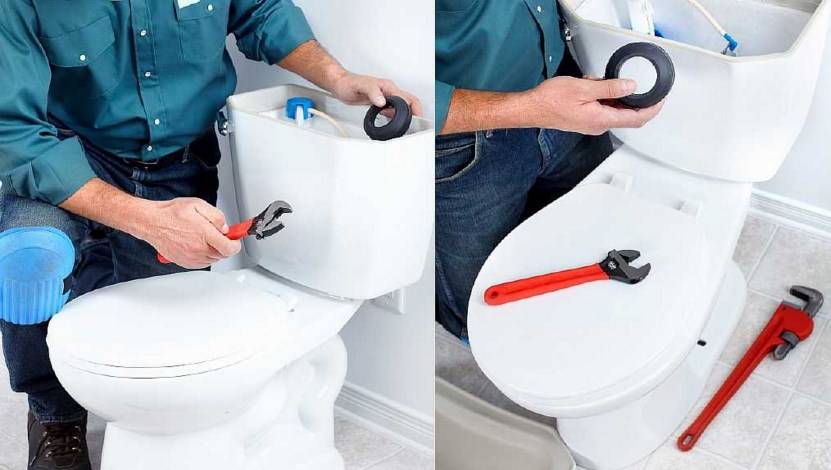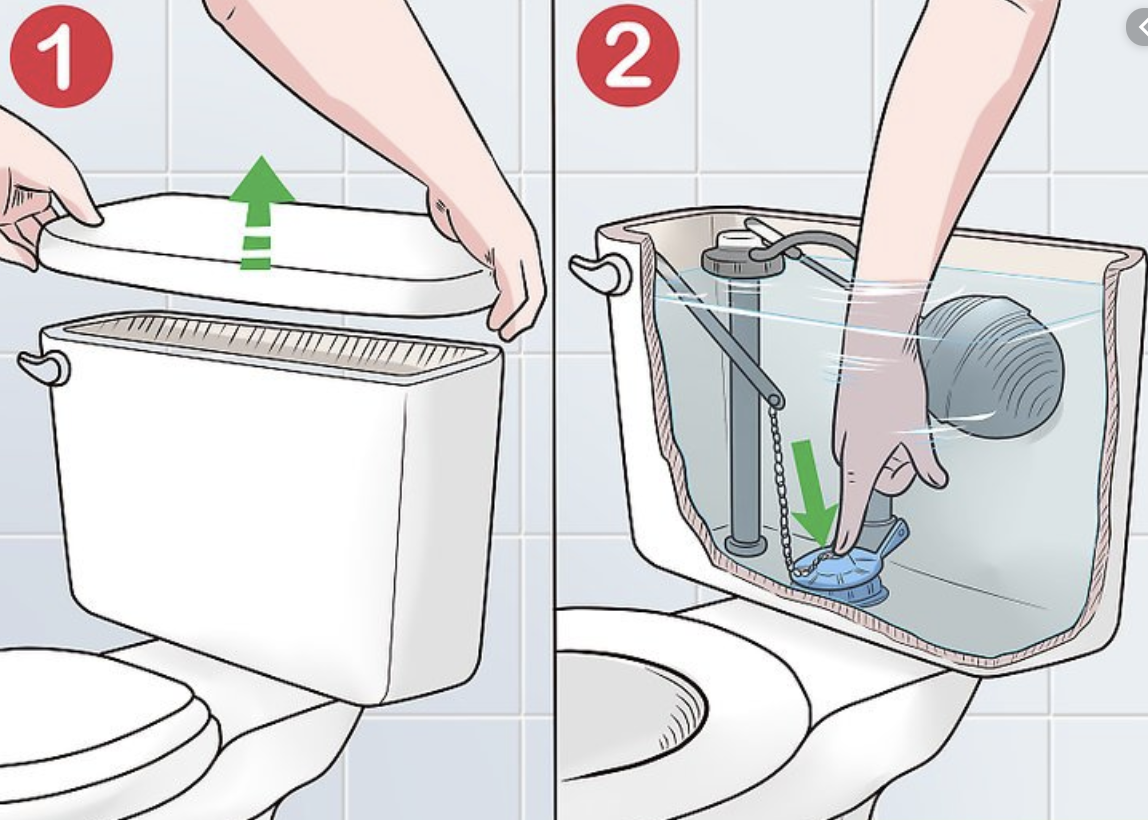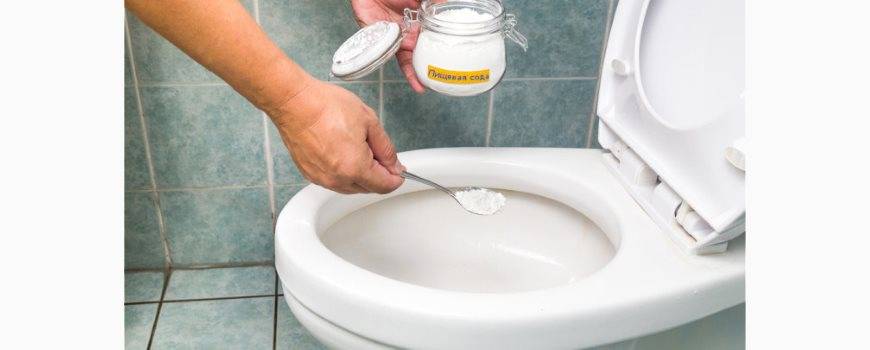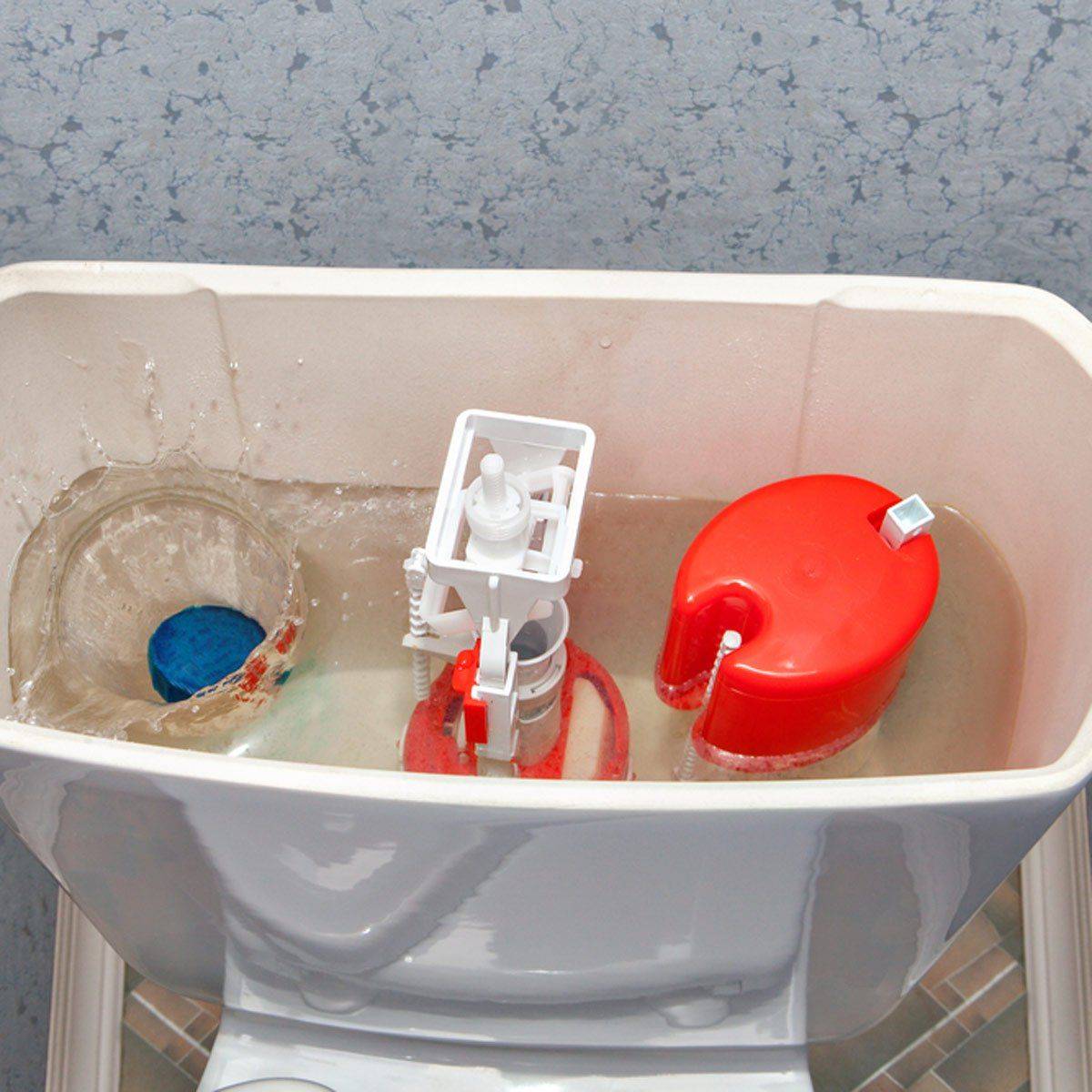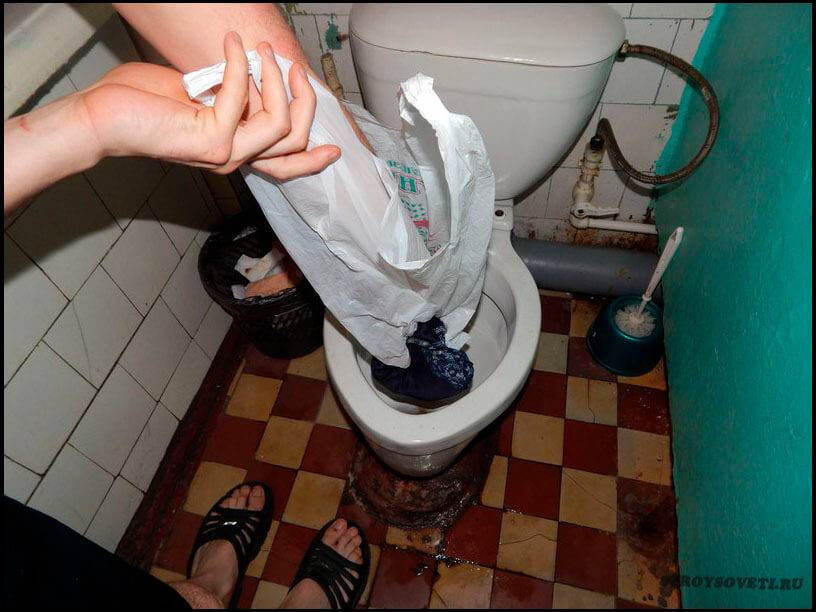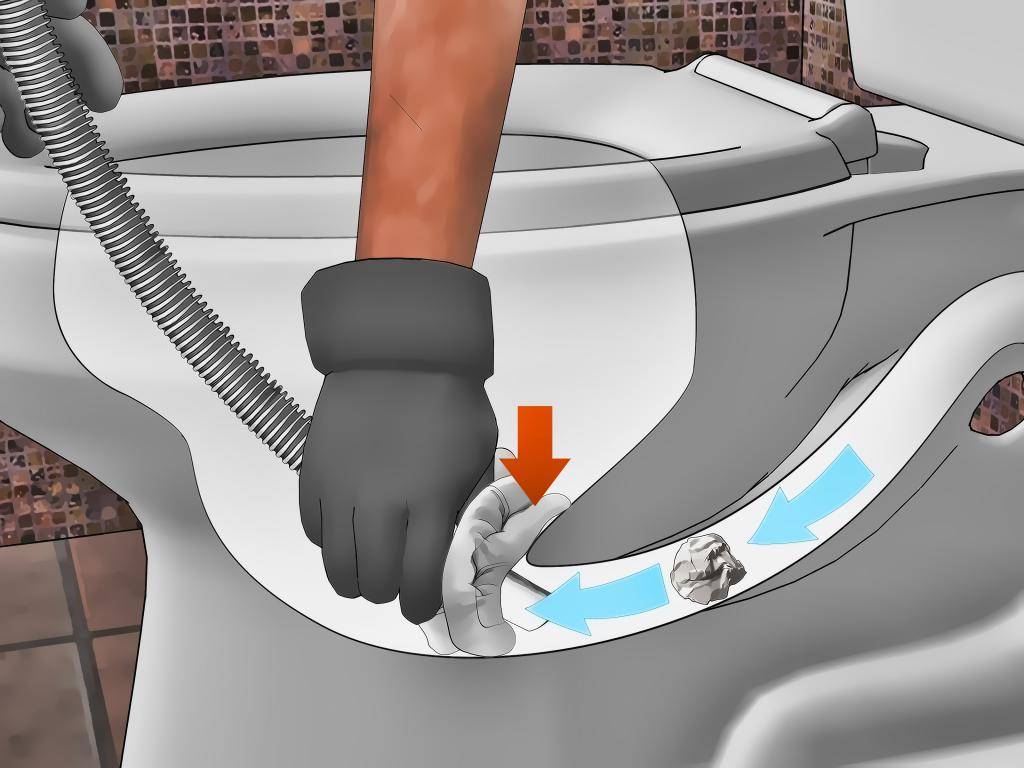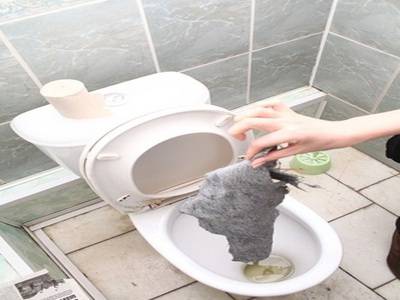Clogged inlet tube
A tube is suitable for any tank, which supplies water to it. It is made of corrugated material and is screwed in with two nuts. If you notice that the liquid does not flow into the tank, or is typed slowly (sometimes for an hour), then turn off the system, remove the tube and knock out all the dirt from it.
Blockages in the supply pipe can form due to poor quality water, which is often encountered in city apartments. Rust deposits can form in systems where the water circuit is built on metal pipes.
After removing the tube, it is worth checking the filter that is at the inlet to the tank. There is a very fine mesh, which often becomes the culprit for a blockage in the supply circuit. It should be rinsed with a generous stream, and the bathroom will be typed properly.

Mechanics and folk techniques
In many houses, there may be necessary things - a plumbing cable and a plunger. If devices are not in the apartment, then they can be easily purchased in specialized stores. Or even try to use folk methods of getting rid of blockages - as practice shows, these methods act on blockages just as destructively. There are several options for cleaning pipes - cleaning methods can be easily combined and selected depending on your desire. All methods have been tested for tens of years and by thousands of people.
- The most famous mechanical method is plunger punching. This is where vacuum is applied. The plunger goes down as deep as possible. Then you need to press on it and pull it sharply towards you. The action will have to be repeated several times. If the method does not help from the blockage, then it is worth turning to the force of pressure. The plunger cap is installed on the drain edge along the liquid cut-off. Until the desired results are obtained, press down firmly with the plunger several times.
- The second well-known method of getting rid of blockages is an ordinary steel plumbing cable. At its end, it is possible to fix special devices (lance, hook or screw), with the help of which they clean the pipe, break through the blockage or pull out its individual parts. The cable is lowered into the toilet and pushed forward until resistance occurs. Then they begin to rotate the handle clockwise, and then pull out the dirt with a cable. It is better to prepare a basin or garbage bin and a rag in advance - it will be dirty.
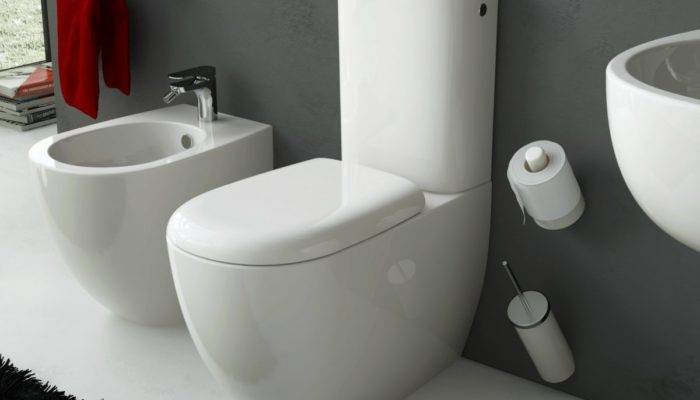
Removing the blockage at home provides a good solution of vinegar and soda. The compound acts the same way as any chemical agent - under the influence of the reaction, the blockage dissolves. A pack of baking soda is poured directly into the toilet, and then vinegar is added there.
The important thing is that the vinegar and baking soda work fast enough.
The rag method also belongs to folk remedies. Helps even in advanced cases
Take an unnecessary towel - you will have to throw it away after the procedure. The thing is twisted and folded in half, and the ends are tied with a rope. You will get a thick tourniquet that needs to be pushed into the pipe. The action is somewhat similar to a plunger, but the towel will fill the entire pipe and handle where the plunger has no effect. With a translational movement, the tourniquet is pushed forward until the water abruptly leaves.
Another good cleansing method is hot water and baking soda. Here you can act in two ways: either dissolve a pack of soda in a bucket and pour the resulting solution into the toilet, or pour soda into the toilet and lower the hot water hose.
The most efficient drainage systems
Knowledge of the plumbing device will help to understand the causes of malfunctions. At its core, a toilet is a bowl to which a flush cistern is connected. Water is drawn into it, and a special mechanism releases it when a key is pressed.
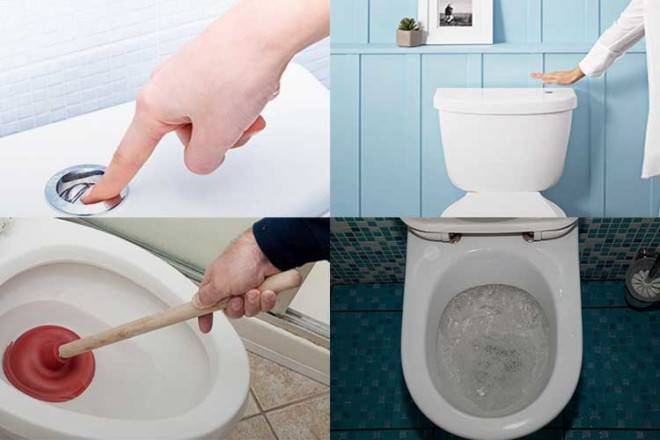
The tank can be made from a wide variety of materials. Most often cast iron and earthenware are used. These materials have proven to be the most reliable. Some varieties are made from regular plastic.
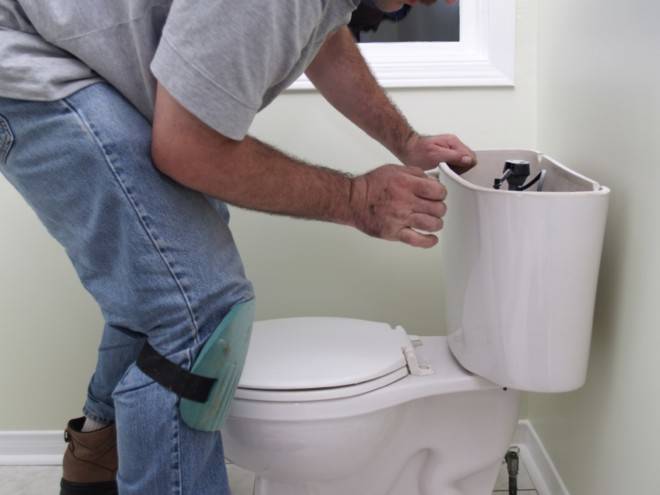
The flush principle divides toilets into two types:
- Cascade - horizontal flush.
- Shower room - vertical flush.
The analysis of manufacturers showed that almost all drainage systems are in demand among buyers. However, the shower method is considered to be more effective.
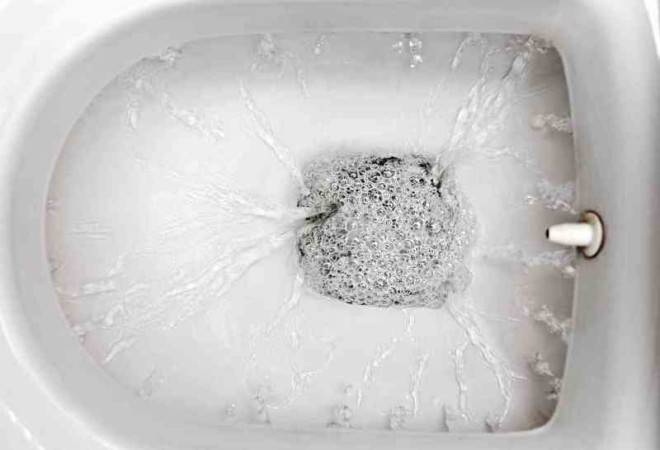
Discharge systems are presented on the market in two main types - top and side. Accordingly, the water flush button is located either on the top cover of the tank, or built into the side.
The upper mechanism includes a special pear. It tightly closes the outlet from the tank at the bottom. When a flush is needed, the mechanism raises the pear and the water quickly flows down the toilet. The side mechanism consists of a special lever that also lifts a small valve. By and large, both options are identical. The only difference is in the location of the buttons and the availability of additional parts.
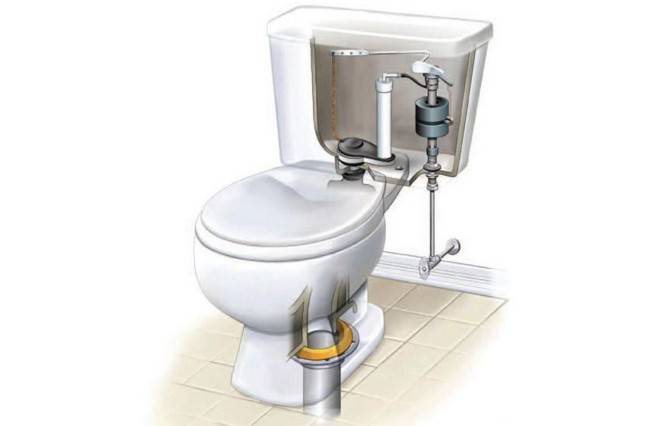
Recently, the automatic type mechanism is gaining popularity. It has a built-in sensor that is triggered by movement. The efficiency of the system is not inferior to the simple mechanical type, but the high cost often repels buyers.
Characteristics of basic chemicals
Tools that are used to clean toilets contain acid or alkali. The most famous of them are Tiret, Mole, Mister Muscle, Flup and many others. They are divided into two types:
- Loose. They are usually packaged in bags. It can be granules or powder.
- Liquid. These are liquids or gels.
There are also remedies that are used from time to time for prophylaxis to avoid blockages. There are others - anti-clogging. They will come in handy if the toilet is already clogged and you don't know what to do.
We fully follow the instructions and send the product down the toilet. After a certain time (indicated on the package), we wash off everything. If the water does not go away, you will have to choose another option from this article.
By the way, residents of the private sector who use a storage septic tank need to be wary of the chemical method. Since an aggressive agent destroys all beneficial bacteria
What to do?
If the toilet is clogged, then measures must be taken immediately. To begin with, it is worth determining where the traffic jam has formed. Most often, a water seal suffers, but a plug can form in drain pipes or in the sewer. Try to drain the liquid in the sink, or in the tub - if the water runs out without problems, then the blockage has formed in the toilet. If the liquid remains, most likely, the problem is in the sewage system. Of course, it is possible to try to fix the situation with your own hands, but, most likely, you cannot do without the help of professionals. If the toilet is also clogged, then you need to remove the blockage. There are several ways to clean the toilet at home:
- mechanical devices;
- chemical agents;
- air;
- hot water.
Sometimes it turns out that it is not possible to break through the blockage, and too intense actions damage the drain pipes, then here you will definitely have to call a plumber - most likely, you will need to replace the sewer riser. It is difficult to do the procedure with your own hands.
If everything is not so bad, then you should pay attention to various ways to eliminate blockages.
- The most elementary way is to clear the blockage with boiling water. It will only help if the water still leaves, albeit slowly. Otherwise there will be no effect, but there will be a flood. You need to pour ten liters of boiling water into the toilet bowl drain. The procedure will have to be repeated several times. Hot water also works well against grease deposits in pipes and blockages. Instead of a bucket of water, you can pour boiling water directly into the tank, but remember that faience cracks and collapses from the temperature drop.Previously, it is better to use warm water or a hair dryer to gradually heat the toilet.
- Another method of removing blockages will still require some material costs. Now there are many strong chemical compounds that destroy any blockages in a short time. How to pierce the toilet is a matter of taste and wallet, all chemicals do a good job with their work. The plumbers themselves recommend using the Mole. Let it not be as fast as in advertising, but it reliably removes blockages.
- If the blockage is close, and no funds were found nearby, then it is worth doing a simple, like an ax, method. Put on long rubber gloves and simply poke a hole in the cork with your hands. The water will go away, and then it will be possible to clean out all the debris.
What causes the malfunction?
In what cases and why is a situation possible when water in the toilet cistern does not flow or is not typed in it? The reasons may be as follows:
Lack of water supply
First of all, it is important to check this particular version. Indeed, sometimes it happens that they cut off the water throughout the house, and the person will look for faults in the drain device.
Incorrect float position (misalignment).
Damage to the supply pipe.
Clogged place where the hose connects to the reservoir
This usually happens after repair work in the pipeline, when the hole is clogged with sand.
Intake valve wear in the mechanism.
Rust in the filter.
Tightly assembled sanitation system.
Formed mucus and plaque.
Toilet cistern problems
The second reason for poor flushing, after a blockage in the bowl, is a faulty flush system, in which it does not flush the toilet bowl well. First of all, you should unscrew the tank button ring, remove the lid and find out the cause of the breakdown.
Float damage
A toilet cistern's float is a hollow plastic container that contains air. When the tank is filled with water, the float rises, as a result of which its lever closes the inlet valve. It happens that water gets inside the float, because of which it cannot rise to the desired level and the valve does not close, which leads to a constant leak. To solve the problem, pour out all the water from the float and seal the hole through which the water entered.
Float lever
A malfunction of the water drain system may be due to damage to the float arm. Over time, it can bend and begin to rest against the wall or some part of the tank fittings. This can lead to either a constant leakage of the toilet, or an incomplete filling of the cistern, which will make it difficult to flush.
To solve the problem, you should correct the angle and position of the lever, or completely replace the element.
Inlet float valve
At the entrance to the toilet cistern, the water supply hose is connected to the inlet valve. When the tank is full, the valve closes and stops the supply of tap water until it is drained. If this valve fails, the following consequences are possible:
- Water does not flow into the tank at all.
- Water enters the tank very slowly.
- Water constantly flows into the tank even when the tank is full, as a result of which there is an overflow and constant flow in the toilet.
Due to the complex design of this element, it will be faster and easier to completely replace it, since even after repair it is unlikely to last long.
Discharge valve and drain column
Due to mineral deposits in the tap water, the bulb of the drain column may not fit tightly against the rubber seal, as a result of which water will constantly leak out of the tank, preventing it from filling. In addition to limescale, the deformation of the rubber elements can lead to such a problem, which happens when there is a prolonged absence of water in the toilet cistern. In this case, the rubber parts dry out and lose their shape, which is why they can no longer fit snugly together.
Main reasons
Often, the toilet flushes poorly due to problems with the water drain system itself. To solve the problem on your own, you must first identify the source of the problem. Let's consider the possible causes of the trouble.
- If the water stagnates, then, most likely, a plug has formed in the sewer. When the liquid passes, but slowly, it means that the blockage is small.
- The drain pipe is small in diameter. With prolonged use, deposits appear on the walls, which interfere with the circulation of water. The pipe can overgrow them, then only 1/3 of the original diameter remains. This happens especially quickly if water is supplied from underground sources. In this case, it is enriched with mineral salts, which additionally clog the drain.
- It is worth checking if there is water in the tank itself. It happens that scale gets into the sewer system, which clogs the hose. Also, the flushing process can be disrupted due to the lack of a tank cap. It must always be reinstalled.
- Debris could have entered the drain. Sometimes it is even rubber hoses from the float valve. They are used to ensure that water from the sewer is drawn as quietly as possible. Typically, the hose will pop off if the tank cap is not in place.
- Float valve not adjusted or set incorrectly. As a result, it shuts off the water supply prematurely.
- The tank is constantly leaking. He simply does not have time to fill with liquid, because it is constantly coming off.
- The float valve is clogged with debris. In its design there is a nozzle into which dross or grains of sand can fall. This does not happen if a filter is installed in the hose in front of the reservoir.
- The supply line to the cistern is clogged with any debris or overgrown. This problem is especially relevant if there are steel pipes in the house.
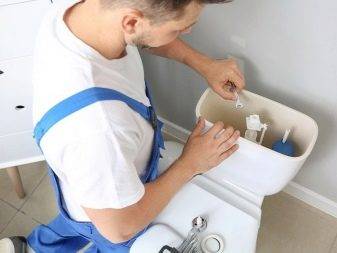

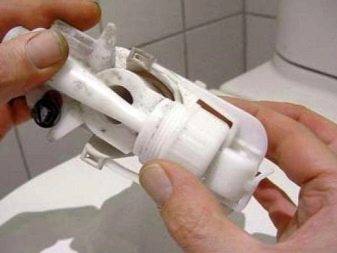
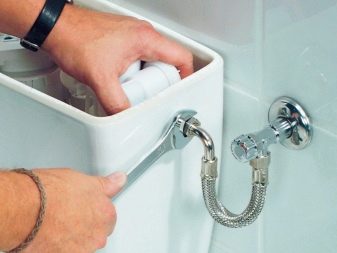
In a private home, toilet problems look a little different. The sewage system here is not arranged in the same way as in the apartments. Often during installation, the norms are not respected, so the liquid passes slowly. Experts identify a number of reasons for poor water permeability associated with poor-quality installation and the devices themselves in general.
- No fan riser. Such a pipe serves as ventilation for the sewer system. It allows the collected gases to escape. In the absence of a fan riser, air plugs form inside the pipes. Because of this, the water stops or simply loses speed. There is also a concomitant symptom of this problem: gases still find their way out of the sewer. In this case, an unpleasant smell can be heard from the toilet, bathtub and sinks.
- Incorrect pipe slope. The problem is associated with improper drainage of the sewage system as a whole. The reason can be both in the section that leads to the septic tank, and in the fact that leads to the connecting pipe. It will not be possible to fix these problems in a simple way.
- Poor toilet design. If the plumbing itself is new, then the problem may be in it. A toilet bowl with a shelf often becomes a source of trouble for its owners. Modern models often have a drain in the center or with a slight slope. In this case, the bowls are shaped like funnels.
- The location of the drain hole in the toilet. Just one outlet for water in the center will not do the job. Washing in a circle is much better and more durable.
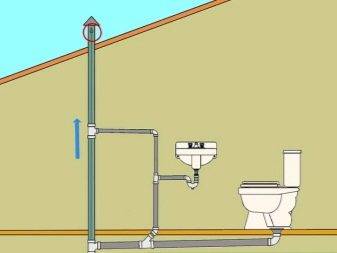

Sometimes the reasons are even more commonplace. For example, models with a button are fraught with danger in it. Especially if the tank lid was removed and placed incorrectly. In this case, you will notice that the toilet is constantly flushing a small amount of water.

It is not only plaque that can clog the water drain holes. Sometimes, plain paper thrown into the toilet can lead to similar problems. It can also cling to deposits inside the drain pipe. In this case, the water does not drain or does it too slowly.
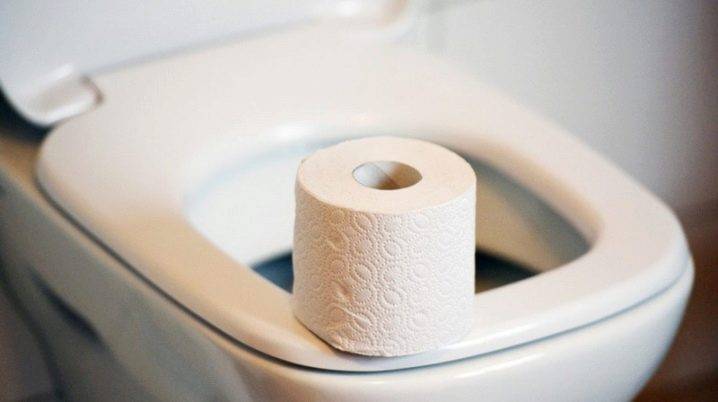
Precautionary measures
So that you don't have to call the plumber or run with cables in the middle of the night, you will have to take some precautions - prevention will help you avoid a lot of trouble. It is worth adhering to some simple rules:
- do not throw foreign objects, large food debris and feminine hygiene items into the toilet;
- do not wash off paper towels, plain paper, newspapers and cling film;
- if large things get into the toilet, do not try to wash it off, it is better to get it;
- do not forget to wash off waste products;
- periodically clean the toilet with chemicals and warm liquid.
Remember that a toilet in a multi-storey building is not a cesspool in a country toilet. Don't throw anything there. And of course, a clean toilet will reduce the risk of clogging.
Prophylaxis
Which toilets flush better? Numerous consumer reviews and the experience of plumbers point to the visor bowl as the most effective in its class.
Efficiency is achieved due to the correct shape of the bowl, which has a slope. This allows the water to churn off the rinsed composition with a large stream, which makes the bowl clean and eliminates the formation of an unpleasant odor. In such models, water does not stagnate.
There is no need to throw food, toilet paper and other indelible things into the circuit. Sooner or later, this will lead to a congestion.
Flush the bathroom regularly with hot water, spill the system with copious amounts of liquid with each use.
When arranging sewer flushes, select the correct eccentrics, corrugations and other types of pipes for connections.
Keep the toilet mechanisms in good working order. Only proper operation will help to avoid problems with congestion and unpleasant odors in the apartment and house.
Preventive measures
If you have found and successfully resolved the reason why the toilet did not flush water well, you should not think that such problems will not arise in the future. The accumulation of limescale and the ingress of foreign objects into the bowl are quite frequent cases. It is almost impossible to avoid them, but to try to prevent them, preventive measures will help.
First of all, it is necessary to ensure that foreign objects do not fall into the toilet bowl. If such a nuisance happened, they must be removed immediately. In addition to this, in order to avoid the accumulation of limescale formation on the walls of the drain, it is recommended to clean it with chemicals once a month. Special powder should be poured into the drain hole and, after waiting 15-30 minutes, rinse with water. To achieve the best effect, periodically, you should clean the drain with a cable.
No less attention should be paid to the drain mechanism of the tank. It is recommended to regularly open the lid of the container and check the functionality of the shut-off valves.
If the slightest malfunction is detected, it will be much easier to make repairs than if a serious breakdown occurs.
Detailed instructions on how to eliminate the causes of a breakdown in the toilet flush system are shown in the video.
Concluding the topic, we note that it is quite simple to identify a problem in the operation of such a necessary plumbing device as a toilet bowl. With a detailed study, you can easily get ahead of the essence of the breakdown. A common cause of incorrect operation is a banal clogging of the drain or a malfunction of the tank shut-off valves. Having identified the problem, you can solve it yourself by studying the recommendations of specialists. Or by calling a plumber at home.
A full tank is not filled
A large number of plumbers say that at least half of all the challenges are related to the lack of water in the tank. This is one of the most common problems faced by homeowners. But not everyone can solve it on their own. What to do about if the toilet does not flush well due to the lack of filling of the tank?

The problem is hidden in the valve. It needs to be adjusted correctly. When adjusting, you can immediately clean the valve.
The tank may not fill up completely also due to the rapid flow of water. This may be due to the fact that the bulb at the bottom of the container does not fit snugly against the saddle.
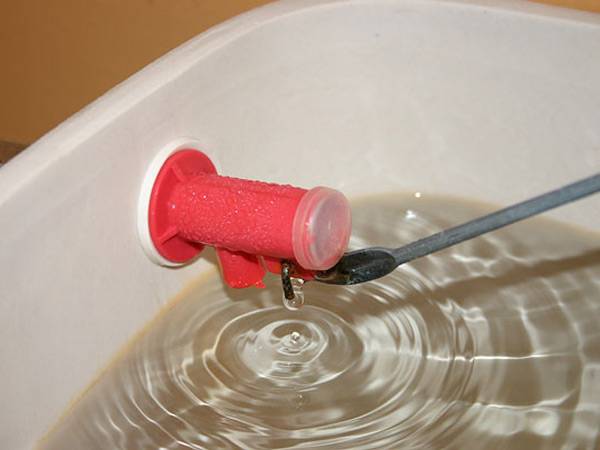
If the stream is weak or water does not enter the container at all, the problem is in the pipes that fit the tank. They need to be changed.
Causes of poor toilet flushing
The most common cause of poor drainage is clogging. The drain becomes clogged, causing the tank to become covered with limescale, which obstructs the flow of water. Debris in the toilet can be a clogging factor.
Another reason is damage to the enamel due to roughness, cracks, scratches and chips of the coating, the accumulation of dirt.
Also common factors for the lack of a good drainage of the toilet are the lack of water in the toilet cistern due to a broken float valve or the float itself and a broken siphon.

Often, a bad drain is due to a poor-quality layout of the sewer system, the absence of a drain pipe, which is responsible for ventilation of gases in the sewage system. As a result, not only does the water not drain evenly, but also an unpleasant sewer odor appears.
Rarely, when the drain is not provided due to the incorrect location and diameter of the slope of the pipes. This occurs due to the lack of checking the installation of the toilet and its operation before use.
Types of mechanisms
Everything is pretty simple here. Mechanisms are side and top. This is a drain button that opens the water retention valve.
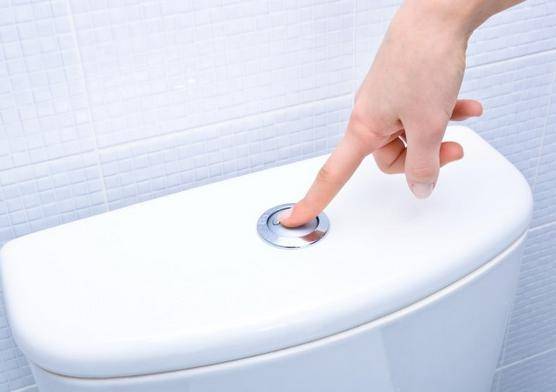
The button is located at the top of the tank lid, or on the side of it. The side mechanism pulls a lever, which in turn raises the valve. And the upper mechanism raises the rubber bulb, which holds back the water pressure. There are also various methods of descent device. These are the usual mechanical ones, when the water is drained by direct contact with the drain button, or automatic, where the whole process takes place without the participation of the user.
Types of installation of the cistern:
- The most common option is that the cistern is fixed above the toilet seat, or it is a monolithic structure, where the cistern and the toilet seat are a single whole.
- The modern type of installation is built-in. The tank is wall-mounted. Only the control buttons remain outside.
- The rarest is the installation of the cistern at the top, almost under the ceiling. This is a vertical descent option.
Causes and manifestations
The source of troubles with the toilet - poor flushing - can be both breakdowns and an unsuccessful design of the bowl or drainage system, and in a private house - also mistakes in planning the sewage system. Let's take a closer look at what can lead to poor flushing and how it manifests itself.
- Clogged toilet siphon or sewer pipe. In this case, the water will stand in the toilet bowl or leave very slowly.
- There is not enough water in the tank. When washing off, it is even visually visible that there is very little water. Sometimes the water from the tank flows incessantly.
- The drain channels in the cistern or toilet are clogged. The water from the tank flows slowly, without pressure.
- Bowl or drain design does not rinse well.
- The enamel covering the inside of the bowl is damaged. This will show that the surface is no longer smooth.
- If there is no fan riser in a private house, an air lock forms in the sewer pipe. In this case, the water can leave slowly and evenly or in jerks - at first it stands, and after a while it quickly leaves.
Having found out the reason, you can proceed to eliminate it. Let's analyze what needs to be done in each case.
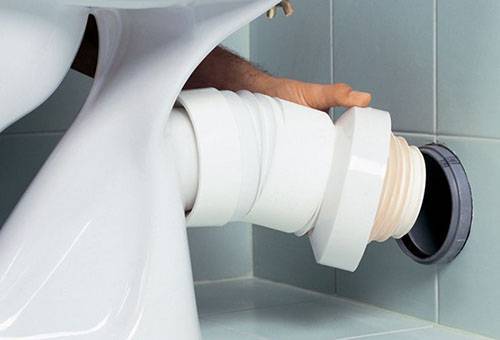
Preventive treatment of the toilet
A one-time toilet repair cannot guarantee its effective functioning in the future. To extend the life of the plumbing, it is necessary to carry out preventive maintenance from time to time. And this applies to the owners of private houses and apartments. Preventive maintenance will help dissolve lime particles that are constantly deposited on the walls.
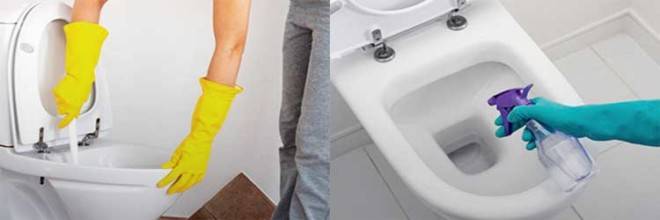
- It is necessary to clean the entire system as often as possible using chemical compounds. Once a month is enough. Funds are poured into the toilet, which should gradually dissolve. After 1 hour, you can drain the water.
- Covers are a prerequisite for proper functioning! They should be both on the toilet and on the tank. This will prevent the ingress of foreign objects.
- Periodically check the condition of the toilet and, separately, the mechanism inside the drain container.
> You can troubleshoot a toilet bowl not only with the help of a wizard, but also with your own hands. To do this, you first need to determine the nature of the problem. If the reasons are clogged passages, use a rope, acids and a plunger. Found a breakdown of parts of the drain mechanism - immediately buy new components.
Recommendations
Oddly enough, it is worth thinking about poor flushing when choosing a toilet and during the first time it is used. Sometimes a bad purchase becomes a problem after months or years. Let's consider the main recommendations in this regard.
It is worth paying attention to the location of the tank. The top always washes away better than the bottom
It provides more powerful water pressure. If possible, then it is worth installing the tank higher.
Pivot flush toilets are good and popular, but they do get in trouble with use. It just so happened that it is the back wall that gets dirty the most. The circular flush washes the entire bowl completely without splashing. However, for the most polluted area, there is little water, and its pressure is rather weak. Therefore, in some cases the flush may be poor.
The visor inside the bowl is a good indicator. Thanks to it, the flushing efficiency is increased. But quite often such a design becomes a source of an unpleasant odor. Waste remains on the visor for too long, which leads to inconvenience. But the flush is really better than its counterparts.
The material of the bowl also matters. Porcelain sanitary ware is considered the best: the surface is smooth, has almost no pores, and nothing interferes with the flow of water. Glazed faience is also good in practice. It is only slightly inferior to porcelain. But ceramics can bring a lot of problems. The enamel on it deteriorates easily, and chips interfere with the circulation of water.
Any tank should be properly monitored. Regularly clean the nozzle and other areas prone to overgrowth.
For information on how to check the correct operation of the toilet flush, see the next video.
There is little water in the tank
If the toilet does not flush well as a result of the fact that little water is poured into the tank, the following reasons and ways to eliminate them are possible.
- The float closes the valve too early. To fix this, just tighten the adjusting screw on the float.
- Debris has fallen between the pear (petal) and the drain hole, and water flows into the toilet all the time. In this case, you need to remove the fittings and clean the drain from debris and plaque.
- The rubber parts above the drain have lost their ductility due to hardness salts or chemicals. Here you will have to buy the corresponding parts and change them.
If the listed actions did not help, most likely the reason is a breakdown of the tank mechanism and here the help of a specialist is needed.
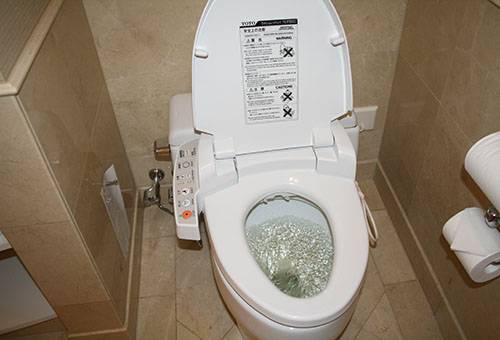
Preventing toilet blockages
After a severely clogged sewer system, people tend to be more careful about what they throw into the toilet. Naturally, at first, while events are fresh in the memory. And yet, you should always remember the basic rules when using the toilet:
do not throw foreign objects into the toilet;
a complete ban on children's games near the toilet, so that nothing falls there;
throw away contraceptives and hygiene products only in the trash bin;
if something has already fallen into the toilet, try to get it out immediately;
in a private house, you should not throw a piece of toilet paper down the drain
Since after a while you will have to get it;
use periodically special preventive chemicals and pay attention to how quickly the water goes away;
it is advisable to purchase a plunger;
you need to choose and install the toilet correctly;
the toilet should be used exclusively for faeces and water !.
You must choose the way to eliminate the blockage yourself, but if the above tips did not help or even aggravated the situation, do not despair. Why? Because, always, you can contact the plumbing service, where experts will help you.
Conclusion
A faulty toilet can cause a lot of problems for residents, such as the constant noise of a filling tank, the noise of a toilet leak, rusty smudges on the white surface of the toilet bowl, increased water bills, an unpleasant rotting smell when clogged, and so on.
In case of a blockage, the situation can be corrected with a plunger, cable or chemical means, and if the tank does not flush well in an apartment or in a private house, it is not at all necessary to buy a new toilet, it is enough to replace the fittings in it.
To search for a specialist in cleaning and repairing plumbing, as well as for solving everyday problems, publish your task on our exchange, indicating the amount that is acceptable for you. After a while, the executors will respond to your instructions.
View recent errands
Repair tips:
Geberit installation: installation features and feedback
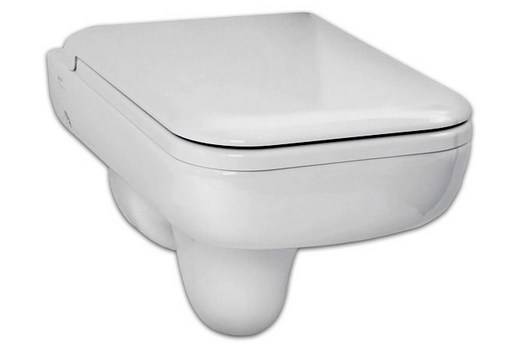 Repair and others like him - Page 171 - Diva.BY forums
Repair and others like him - Page 171 - Diva.BY forums
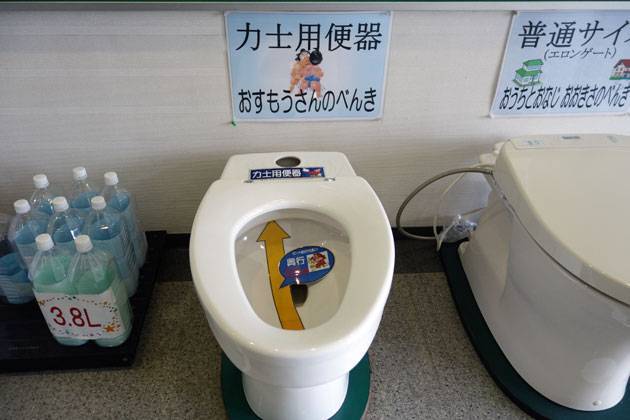 Smart toilet: an overview of the possibilities. Japanese toilet ::.
Smart toilet: an overview of the possibilities. Japanese toilet ::.
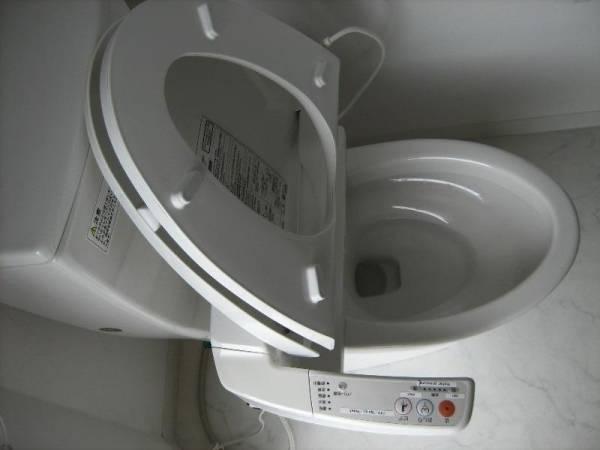 Toilet seat with microlift, its selection and installation
Toilet seat with microlift, its selection and installation
Categories Toilet Post navigation
Leave a Comment
Comment
This site uses Akismet to combat spam. Find out how your comment data is processed.
Categories
- Lego
- Acrylic
- Accessories
- Accessories
- Arches
- Balconies
- Banquet
- Bath
- B-B-Q
- Alcove
- Concrete
- Concrete
- Block house
- Sconce
- Lining
- Bathroom
- Ventilation
- Veranda
- Household vintilator
- Internal
- Water heaters
- Water supply
- Gutter system
- Water-based
- Gates
- Input
- Hood
- Aerated concrete
- Gas
- Gas water heaters
- Garage
- Wardrobe
- Sealants
- Waterproofing
- Drywall
- Drywall
- Living room
- Grill
- Primer
- Doors
- Bunk bed
- Wood
- Children's room
- Baby bed
- Playground
- Sofas
- Design
- Design
- Closers
- House
- Log house
- Log house
- Drainage system
- Other
- Shower
- Shower cabins
- Blinds
- Magazine
- Fence
- Soundproofing
- Insulation materials
- Instruments
- Stone
- Fireplace
- Sewer
- Sewerage
- Frame house
- Eaves
- Studio apartment
- Porcelain stoneware
- Brick
- Brick house
- Pantry
- Carpet
- Carpets
- Carpets
- Well
- Computer
- Smokehouse
- Boilers
- Ball valve
- Paints
- Porch
- Roof
- Living room kitchen
- Kitchen studio
- Couch
- Lucky
- Laminate
- Landscape design
- Ladder
- Linoleum
- Chandeliers
- Braziers
- Attic
- Materials (edit)
- Mattresses
- Furniture
- Furniture
- Furniture
- Furniture
- Interroom
- Metallic
- Metal tile
- Mineral wool
- Models
- Mosaic
- Polyurethane foam
- Assembly adhesive
- Pillowcases
- Bulk
- Floor coverings
- Outdoor
- Pumping station
- Pumps
- Tension
- Filament curtains
- Wallpaper
- Blankets
- Window
- Lighting
- Decoration Materials
- Slopes
- Heating
- MDF panels
- PVC panels
- Parquet
- Greenhouse
- Vapor barrier
- Foam concrete
- Hinges
- Ovens
- Writing
- Layout
- Layout
- Plastic
- Plastic
- Tile
- Land area
- Whitewash
- Cellar
- Cellar
- Basement
- Window sills
- Cushions
- Bedspreads
- Floor
- Polypropylene
- Towels
- Linens
- Bedding
- Ceiling
- Ceiling
- Hallway
- Projects
- Radiators
- Sliding
- Sinks
- Repair
- Renovation finishing
- Pens
- Siding
- Plumbing
- Barn for chickens
- Light fixtures
- Septic tank
- Well
- Mixers
- Solar panels
- Bedroom
- Log house
- Walls
- Walls
- Table
- Construction
- Chairs
- Screed
- Dry mixes
- Ottoman
- Home textiles
- Greenhouse
- Warm
- Terrace
- Pipes
- Toilet
- Smart House
- Toilet bowl
- Warming
- Facade
- Facade
- Filters
- Filters
- Foundation
- Fittings
- Cement
- Attic
- Shingles
- Slate
- Cupboard
- Putty
- Curtains
- Plaster
- Electric grill
- The elements
- Enamels
Recent Entries
- Dulux Master 30 - Dulux Master 30
- How to clean the charcoal filter in the range hood
- Stretch ceiling in the bedroom: 65 photos, ideas and ceiling design
- Semi-warm glazing - "With a Balcony"
- Suburban area of 6 acres, arrangement - photo examples

